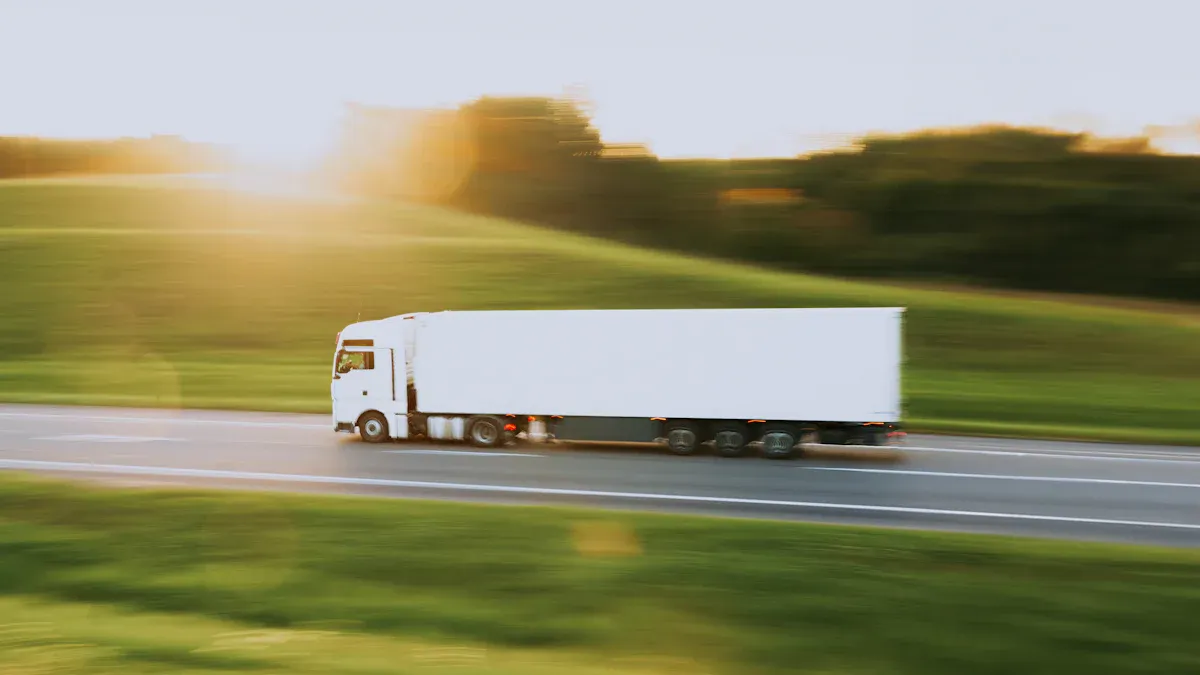How Logistics Companies Can Cut Environmental Impact with Green Practices

You can reduce your company’s environmental impact by adopting green practices. The logistics industry produces about 11% of global greenhouse gas emissions when warehousing is included. Freight transportation alone makes up nearly 8%. Logistics operations account for 8 to 10 percent of global carbon emissions, which shows the urgent need for sustainable solutions. Many businesses now consider sustainability a critical goal. You will find environmental benefits in logistics when you make smart changes.
45% of businesses see sustainability as a top priority for 2025.
New regulations push companies to meet stricter emissions targets.
The U.S. government enforces tougher standards for emissions reduction.
Key Takeaways
Adopt green practices to reduce your logistics company's environmental impact and save costs.
Optimize delivery routes using technology to cut fuel use and lower emissions by up to 20%.
Switch to eco-friendly vehicles to lower your carbon footprint and meet new regulations.
Reduce packaging waste by using reusable and recyclable materials to minimize landfill contributions.
Utilize data analysis to identify inefficiencies and set clear sustainability goals for your operations.
Environmental Challenges in Logistics

Transportation Emissions
You face big challenges with transportation emissions in logistics. Transportation produces more greenhouse gases than most other industries. In 2022, transportation made up 29% of total U.S. greenhouse gas emissions. This number grew by 19% from 1990 to 2022 because people travel more and vehicles drive longer distances. Diesel-powered trucks and vans still move most goods. This heavy fuel dependency makes it hard for you to switch to greener options. When you operate across many countries, you must follow different rules, which can be confusing and slow down progress.
Transportation emissions are the largest direct source of greenhouse gases in the U.S. You can help lower these emissions by choosing cleaner vehicles and planning better routes.
Warehousing Energy Use
Warehouses use a lot of energy every day. You need heating, lighting, and cooling to keep goods safe. These systems account for most of the energy used in logistics buildings. The table below shows where most energy goes in warehouses:
Source of Energy Consumption | Percentage of Total Consumption |
|---|---|
Heating and Lighting | 76% |
Refrigeration (Refrigerated Warehouses) | 60% |
Computers and Technology | 6% |
Ventilation Systems | 5% |
Cooling (Non-Refrigerated Warehouses) | 14% |
Natural Gas for Heating | 87% of natural gas use |
You can see that heating and lighting use the most energy. If you improve these systems, you will save energy and money. You also gain environmental benefits in logistics by reducing your carbon footprint.
Packaging and Waste
You must manage packaging and waste in logistics. Many companies use too much packaging, which creates more trash. Cardboard, plastic, and foam often end up in landfills. You can reduce waste by choosing reusable or recyclable materials. Setting realistic goals for waste reduction is hard if you do not have good data. Constant changes in regulations mean you must update your methods often. Good data management helps you track progress and meet new standards.
Tip: Start by measuring your waste and looking for ways to reuse or recycle packaging. Small changes can make a big difference.
Green Practices in Logistics

You can make a big difference by adopting green practices in your logistics operations. These steps help you save money, improve efficiency, and deliver strong environmental benefits in logistics.
Route Optimization
You can cut fuel use and lower emissions by planning smarter delivery routes. Route optimization uses technology like GPS, routing algorithms, and traffic data integration to find the best paths for your vehicles. This reduces the number of miles driven and helps you avoid traffic jams.
Evidence Type | Description |
|---|---|
Fuel Reduction | Route optimization can lead to a decrease in delivery vehicle emissions, significantly lowering overall transportation CO2 emissions. |
Efficiency | Advanced routing software creates efficient routes, considering traffic and vehicle load, which reduces fuel and CO2 emissions. |
Carbon Footprint | Optimizing delivery routes can reduce travel distances by 10-30%. |
Route optimization can decrease fuel costs and emissions by up to 20%.
Efficient route planning reduces the number of kilometers driven, leading to lower exhaust emissions.
You can use technologies such as GPS, geofencing, and delivery management software to track vehicles and adjust routes in real time. These tools help you lower your carbon footprint and meet sustainability goals.
Tip: Use data analytics to review your delivery routes and find areas where you can save fuel and reduce emissions.
Load Consolidation
You can reduce the number of trips your trucks make by consolidating loads. Load consolidation means combining shipments from different customers or locations into one truck. This practice lowers fuel use and cuts down on empty miles.
Impact Area | Effect of Load Consolidation |
|---|---|
Number of Trips | Reduces frequency of shipments |
Fuel Consumption | Lowers fuel use by minimizing empty miles |
Overall Emissions | Decreases emissions through optimized truck capacity |
Load consolidation decreases fragmented shipments, leading to fewer trips.
Industry estimates show that empty miles can account for up to 20% of total truck miles, which load consolidation helps to reduce.
You can collect cargo at a central hub, sort and package based on destination, and optimize load planning to maximize space. Cross-docking and multi-client consolidation also help you share transport resources and reduce costs.
Note: Effective planning and open communication among stakeholders are key to successful load consolidation.
Eco-Friendly Vehicles
Switching to eco-friendly vehicles brings strong environmental benefits in logistics. Electric trucks, hybrid vehicles, and those using alternative fuels like natural gas or hydrogen produce fewer emissions than diesel trucks.
At least 50% of logistics fleets have operated a battery-electric vehicle.
92% of those fleets plan to expand their use of electric vehicles.
85% of fleets currently use electric yard trucks.
Alternative Fuel | Environmental Benefit |
|---|---|
Natural Gas | Produces less greenhouse gas emissions compared to traditional fuels. |
Hydrogen Fuel | Generates only water vapor as a by-product, making it a clean fuel option. |
Ethanol Fuel | Offers a lower-emission alternative when blended with petrol. |
Liquefied Petroleum Gas | Burns more cleanly than petrol and diesel, resulting in fewer harmful emissions. |
You can lower your carbon footprint and improve air quality by investing in electric and alternative fuel vehicles. These changes also help you meet new regulations and customer expectations.
Sustainable Warehousing
You can make your warehouses more sustainable by using energy-efficient technologies and building practices. Solar panels, wind turbines, and microgrids generate clean energy and reduce your reliance on the main power grid.
Technology | Description | Energy Efficiency Impact |
|---|---|---|
Solar Panel Installations | Advanced solar systems on rooftops generating significant energy, including bifacial panels. | Operate off-grid for several hours a day. |
Wind Turbines and Microgrids | Small wind turbines and microgrids enhance energy resilience and independence from the main grid. | Sell extra power to the grid during peak. |
Automated Storage and Retrieval Systems (AS/RS) | Robotic systems that maximize storage density and reduce energy consumption. | 20-30% energy savings. |
Robotic Picking and Packing | Advanced robotics that operate in dimly lit spaces, reducing the need for lighting and climate control. | 30% drop in packing material waste. |
Green Roofing and Insulation | Vegetation-covered roofs that improve insulation and biodiversity while generating energy. | Up to 30% less energy for heating/cooling. |
Recycled and Sustainable Materials | Use of eco-friendly materials like bamboo and recycled steel to reduce environmental impact. | Smaller carbon footprint in construction. |
You can also use automated systems and robotics to save energy and reduce waste. Companies like Pilsner Urquell and Schwälbchen dairy have cut energy costs by increasing storage capacity and using mobile racking.
Tip: Review your warehouse energy use and invest in technologies that lower consumption and boost efficiency.
Reducing Packaging Waste
You can cut packaging waste by switching to reusable, recyclable, and biodegradable materials. Many logistics companies now use reusable pallets, crates, and containers. Biodegradable plastics and recycled cardboard help you minimize landfill waste.
Automated sorting systems separate recyclable materials from trash.
Digital documentation and paperless systems reduce paper waste.
Plant-based and seaweed packaging offer new ways to protect goods without harming the environment.
You can also use automated sorting to improve recycling rates and reduce landfill contributions. These steps deliver environmental benefits in logistics and help you meet customer demands for sustainable packaging.
Callout: Start by measuring your packaging waste and set goals to increase the use of eco-friendly materials.
Using Data Analysis for Improvement
You can use data analysis to find areas where you can improve your environmental impact. By collecting and studying data on fuel use, energy consumption, and waste, you identify inefficiencies and set clear sustainability goals. Data analytics helps you make smart decisions, optimize your supply chain, and reduce waste.
Note: Regularly review your data to track progress and adjust your strategies for better results.
Environmental Benefits in Logistics
You can see many environmental benefits in logistics when you choose green practices. These changes help you lower emissions, improve air quality, and save resources. You also gain cost savings and a stronger reputation with customers and partners.
Lower Carbon Footprint
You reduce your carbon footprint by using cleaner vehicles, optimizing routes, and switching to rail transport. Many companies have already seen big results:
Ocean Spray redesigned its distribution network and shifted from road to rail, cutting transportation CO2 emissions by 20%.
Caterpillar streamlined shipping and packaging, reducing carbon emissions by up to 730 tonnes of CO2 each year.
Boise switched to rail transport only, eliminating over 2,600 tons of CO2, which equals saving more than 264,000 gallons of fuel.
These steps show how you can achieve measurable reductions in emissions and support efforts to slow climate change.
Improved Air Quality
Green logistics practices help you create cleaner air, especially in cities. The table below shows how different actions improve air quality:
Description | Impact on Air Quality |
|---|---|
Reduces transportation emissions, leading to cleaner air | |
Real-time route optimization | Avoids high-pollution zones, lowering harmful pollutants |
Air quality monitoring | Raises awareness and supports better air quality |
Companies like DHL, Amazon, and UPS using electric vehicles | Drastically reduces air pollution while staying efficient |
Cleaner air means healthier communities and fewer health problems for people living near busy roads and warehouses.
Resource Conservation
You conserve resources by using less fuel, reducing waste, and choosing eco-friendly materials. Here are some ways you can save resources:
Reduce fuel consumption
Minimize packaging waste
You can also:
Optimize packaging to reduce waste
Use eco-friendly materials
Promote reusable packaging
Minimize the size and weight of packaging
These actions help you protect the environment and use resources wisely.
You also save money by lowering fuel costs, reducing maintenance expenses, and streamlining your supply chain. Customers notice your commitment to sustainability, which improves your reputation and builds loyalty. When you work with environmental organizations, you show that you care about the planet and attract partners who share your values.
You gain environmental benefits in logistics while making your business stronger and more respected.
Success Stories and Implementation
Case Studies
You can learn from companies that have made real progress with green logistics. Many leaders in the industry have adopted new strategies to lower their environmental impact. The table below shows how some well-known companies have succeeded:
Company | Strategy | Outcome |
|---|---|---|
NxtLog | Innovative tools and strategies | Reduced environmental impact and improved efficiency |
DHL | Carbon management strategies | Lowered emissions and set a goal for climate neutrality by 2050 |
Amazon | Solar panels on warehouses | Reduced carbon footprint and aims for net-zero emissions by 2040 |
IKEA | Solar panels in warehouses | Working toward climate-positive status by 2030 |
Walmart | Electric trucks and optimized routes | Reduced carbon emissions and fuel use |
DHL uses carbon management to cut emissions and plans to reach climate neutrality.
Amazon invests in solar panels for its warehouses and targets net-zero emissions.
IKEA equips its warehouses with solar panels to become climate-positive.
Walmart uses electric trucks and better delivery routes to lower fuel use.
These companies show that you can make a difference by choosing green solutions.
Implementation Tips
You can start your journey toward sustainability by following clear steps. Begin with a review of your operations to find areas for improvement. Use electric vehicles or alternative fuels to lower emissions. Plan delivery routes with GPS and AI to save fuel. Enhance your supply chain to reduce waste.
Assess your logistics operations.
Switch to electric or alternative fuel vehicles.
Avoid fast shipping options.
Raise awareness about your green efforts.
Offer a green checkout option.
Use big data for better decisions.
Join programs like SmartWay.
Use technology to streamline processes.
You should train your employees about green logistics. Workshops and training programs help everyone understand the benefits and learn new skills. Involve your team in planning and give them the tools they need. A supportive work environment encourages everyone to take part.
Partnering with green suppliers brings new business opportunities and improves your reputation. Customers notice your commitment to sustainability and trust your brand more.
Tip: Start small and build on your success. Every step you take helps protect the environment and strengthens your business.
You can make a real difference by taking simple steps to cut your company’s environmental impact. Start by using logistics software, optimizing routes, and tracking your carbon footprint. Try these actions:
Choose green transportation modes
Use eco-friendly packaging
Reduce empty miles and waste
Invest in renewable energy and electric vehicles
Practice | Environmental Benefit |
|---|---|
Recycling initiatives | Supports a circular economy |
Employee education | Builds a culture of sustainability |
Begin with small changes. Over time, you will see big results. Lead your team by setting clear goals and using technology to drive progress. Your actions help the planet and strengthen your business.
FAQ
What is the easiest way to start green logistics?
You can begin by tracking your energy use and waste. Choose one area, like packaging or delivery routes, and make small changes. Use software to help you measure progress.
How do green vehicles help my company?
Green vehicles use less fuel and produce fewer emissions. You save money on fuel and maintenance. Customers trust companies that care about the environment.
Can data analysis improve sustainability?
Yes. You can use data to find waste and spot problems. Data helps you set goals and track your results. Many companies use analytics to plan better routes and reduce costs.
What are some eco-friendly packaging options?
You can use recycled cardboard, reusable crates, or biodegradable plastics. Many companies also try plant-based packaging. These choices help you cut waste and protect the environment.
See Also
Key Strategies for Effective Management of Global Logistics
Enhancing International Operations Through Innovative Logistics Solutions
Boosting Global Efficiency with Point-to-Point Logistics Systems
Streamlining Supply Chains in the USA with Global Logistics
Optimizing Inventory and Distribution via Global Logistics Warehousing
